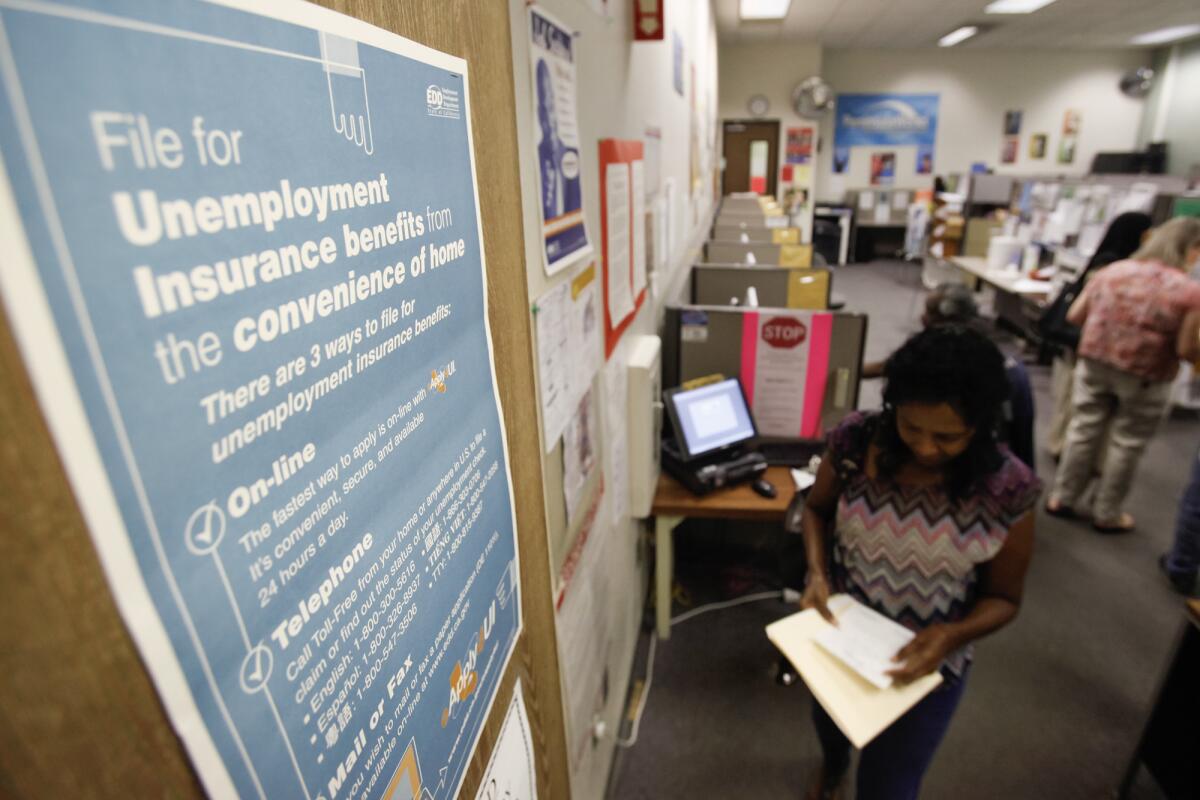As job growth in California falls back, unemployment rate remains highest in the country

- Share via
California posted another month of anemic job growth in April, keeping the state’s unemployment rate the highest in the country, 5.3%, the government reported Friday.
Statewide, employers added a net of just 5,200 jobs in April, down from 18,200 in March, according to California’s Employment Development Department.
Nationwide, employers added 175,000 jobs in April and 315,000 in March. The U.S. unemployment rate in April was 3.9%.
Major sectors of California’s economy — including manufacturing, information and professional and business services — showed job losses last month, and job opportunities aren’t as plentiful as before, even as the number of unemployed workers in the state has risen by 164,000 over the last 12 months.
In California, there were 140 unemployed workers for every 100 job openings in March, according to federal statistics released Friday. Less than two years ago, there were about two openings for every jobless person.
Carol Jackson, an unemployed worker in South Los Angeles, says she has been pounding the pavement for months, hoping to make use of her recently minted associate degree in web management and database administration. But despite sending her resume to at least 100 employers, she has not had a single interview.
“I can tell you that California is pretty brutal now,” said Jackson, 57.
Hiring in California has been lagging behind national trends, with one notable exception. The state’s healthcare and social assistance sector added 10,100 jobs last month, bringing the gains over the last 12 months to about 155,000. That’s 75% of all new jobs added since April 2023.
Hospitals and doctors’ offices have been bulking up, but the fastest growth has been at outpatient centers, home healthcare firms, nursing facilities and, especially, social assistance, which includes vocational rehabilitation and child day-care services.
“Healthcare is the big gorilla in the room; it dominates everything,” said Mark Schniepp, director of the California Economic Forecast in Santa Barbara, adding that it’s likely to keep growing robustly with new and expanded medical facilities across the state.
Leisure and hospitality businesses added 3,100 jobs last month. The gains included employment at hotels and restaurants — despite the added stress employers are feeling from a minimum wage increase to $20 an hour for fast-food workers that went into effect April 1.
While there are fears of layoffs as the food industry adopts technology to replace workers, California’s restaurants are getting a lift from a pickup in tourism. The leisure sector overall is close to fully recovering from the deep losses caused by the COVID-19 pandemic.
Public-sector payrolls also held up well last month, increasing by 2,600. Thus far, state and local government jobs seem to be showing little effects from California’s massive budget deficits.
“But clearly that will be another factor,” said Sung Won Sohn, economics professor at Loyola Marymount University in Los Angeles.
Sohn and other economists worry that there are national, cyclical and state-specific threats to California’s employment and broader economic outlook.
Key pillars of the state’s economy continue to struggle.
Motion picture producers and other employers in the information sector show few signs of breaking out of the hiring doldrums, despite the film industry’s resolution of labor strikes last fall. Los Angeles’ motion picture and recording studio industries were down by 13,400 employees, or 12%, in April compared with the same month a year earlier. And many workers in the industry say conditions do not appear to be improving.
Large parts of the farm economy in the Central Valley remain sluggish, in part due to rising costs, tighter financial conditions and ongoing climate challenges.
Despite strong investments in artificial intelligence, layoffs have persisted at high-tech firms in the Bay Area and elsewhere. Scientific and technical companies shed jobs last month, and employment at computer systems design work and related services has been gradually declining.
Nationally, economists expect job growth to slow in the coming months, the result of persistently high interest rates and an expected pullback from consumers. The outlook is particularly dim in California.
“On the ground, there are several signs of even more slowdowns,” said Michael Bernick, an employment lawyer at Duane Morris in San Francisco and former director of the state’s EDD. Among them, he said, “small businesses continue to struggle statewide with higher prices and tightened consumer spending.”
He and other experts have a similar refrain about what ails the state: high costs, excessive regulation and unaffordable home prices, among other factors.
“We just have real challenges here in California that other states don’t face,” said Renee Ward, founder of Seniors4Hire.org, a Huntington Beach-based organization that helps older workers find employment.
She said the number of job seekers registered with her service has jumped 26% so far in 2024 from a year ago.
More to Read
Inside the business of entertainment
The Wide Shot brings you news, analysis and insights on everything from streaming wars to production — and what it all means for the future.
You may occasionally receive promotional content from the Los Angeles Times.











